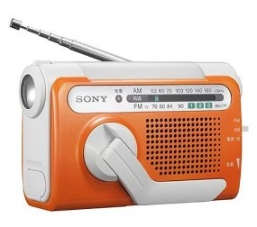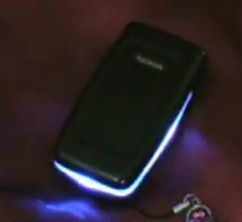Potentially Useful or Plain Stupid? - Some hardware suggestions for modern mobile phones
In a sequel to last week's Useful Or Useless article, we take a look at some hardware features which aren't present on current phones, but perhaps should be. As always, please don't take these ideas too seriously, and do read the "On The Other Hand" sections which follow them.
- Standard Size Batteries (AA, AAA etc)
 When the first personal portable devices such as Sony's Walkman and Psion's Organiser appeared, they almost all used normal third party battery sizes. This continued for many many years, and even in 2001 Nintendo's Game Boy Advance used two totally standard AA batteries. There are in fact still some devices that have compartments designed for standard batteries, such as SanDisk's Sansa Shaker, though these are becoming very rare.
When the first personal portable devices such as Sony's Walkman and Psion's Organiser appeared, they almost all used normal third party battery sizes. This continued for many many years, and even in 2001 Nintendo's Game Boy Advance used two totally standard AA batteries. There are in fact still some devices that have compartments designed for standard batteries, such as SanDisk's Sansa Shaker, though these are becoming very rare.
But devices began to demand so much power that it became impractical to use throwaway batteries with them. Recharging was so much more convenient, and practically every device started including a built-in proprietary cell which could be charged while inside the gadget.
Was the move really necessary though? There are rechargeable standard size batteries now, and always have been. The capacity of a single AA or AAA rechargeable lithium battery is comparable to a dedicated mobile phone battery, as is the volume and weight, so would it be a good idea to use standard size batteries in a phone?
It would certainly make life easier in terms of buying spare batteries, and would allow a battery to be easily used in many different devices. Battery prices would also go down as manufacturers could concentrate on just one or two sizes.
And, perhaps most handy of all, in an emergency you could use throwaway standard batteries, which are available in practically every supermarket and electrical shop in the world.
ON THE OTHER HAND: It's not quite as simple as it seems once you delve into the details, rechargeable AA and AAA batteries may have enough capacity but may not be able to supply the correct voltage required by a modern phone. Another headache would be their shape, which tends to be much thicker than phone batteries and so require thicker phones (or at least bulgy ones), and they would also demand physical connections at both ends of the battery.
- Wi-Fi Video Calls
Suggested by several AAS readers in response to our previous article, a potentially very popular use for a phone's front camera would be videophone calls through Wi-Fi. Wi-Fi calls don't suffer as much from latency as phone network calls, and they are usually much cheaper or free. This is already possible on many computing devices, including Nokia's own N800 and N810 internet tablets, but for some reason it's rare on phones, possibly due to pressure from phone networks wanting to preserve video call profits.
ON THE OTHER HAND: Whether made through the phone network or Wi-Fi, video calls have an innate lack of privacy and convenience compared to voice calls (though the privacy can be somewhat restored using headphones).
- Torches
Whatever happened to proper torches on phones? Once they were everywhere, then they seemed to disappear completely. Screens are fairly bright, but they're no match for a dedicated white LED which concentrates its light more tightly in one direction. In theory LED camera flashes could be used instead, but most flash-equipped cameraphones don't allow this by default.
ON THE OTHER HAND: The brightness of a screen is perhaps good enough for most people, and adding an extra LED would take up space (though allowing camera LEDs to be used would not require any extra space at all).
- Side Lights
This has been mentioned before but it deserves to be mentioned again: if a phone has its screen pressed against the side of a bag, it's impossible to find when it's ringing. A solution to this was present on the Nokia 3220 and 2650, lights along the sides of the phone so that it's visible from many angles, but apart from these two models nothing else seems to include such lights. Surely it's time they made a comeback, at least on one model?
ON THE OTHER HAND: Some (rather conservative!) people might consider them a bit gimmicky.
- Analogue Volume Controls
How often have you been listening to music on a phone and found that the perfect volume lies between two of the notches on the virtual volume control? It's frustrating, and it feels like a step backwards for audio equipment, because old-fashioned analogue volume controls allowed a practically infinite number of volume settings. Perhaps analogue volume controls could make a comeback?
ON THE OTHER HAND: The analogue dials seen on the Walkman etc were actually rather large, and took up a lot of room as the dial consisted of a rather large wheel with just its edge poking out of the side. They were also very easily nudged in your pocket, and would frequently get knocked onto a wrong setting because nothing physically locked them into place. A much easier answer may simply be to increase the number of virtual volume notches in phone music player apps.
 - FM Radio Aerials
- FM Radio Aerials
"Bored of the music on my phone, think I'll listen to the radio." (gasp) "Oh no, I forgot my headphones, and it won't work without them!"
Yes, the FM radio is both the best and worst feature on a phone as it offers access to totally free radio stations but it can't receive a darn thing without headphones plugged in to act as the FM aerial. A way round this would be some sort of built-in aerial which could slide out when required, as seen on portable radio sets.
ON THE OTHER HAND: This writer can just see the comments now: "Nooooo, no no no, no more aerials on phones! They look so stupid!" Phones with aerials have an unenviable reputation as being primitive and belonging to past generations of hardware. The first mobiles without any visible aerial were regarded as an aesthetic breakthrough, and it seems unlikely that most people would ever want to go back to something resembling a walkie talkie.

